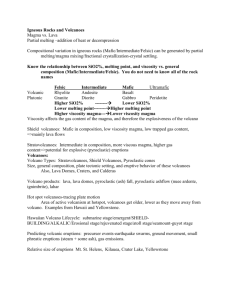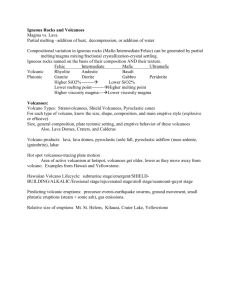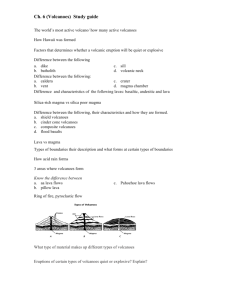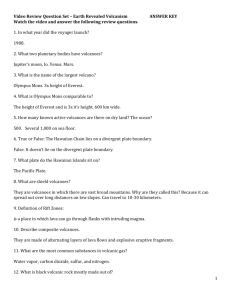Physical Geology - Volcanoes and Volcanic Rocks
advertisement
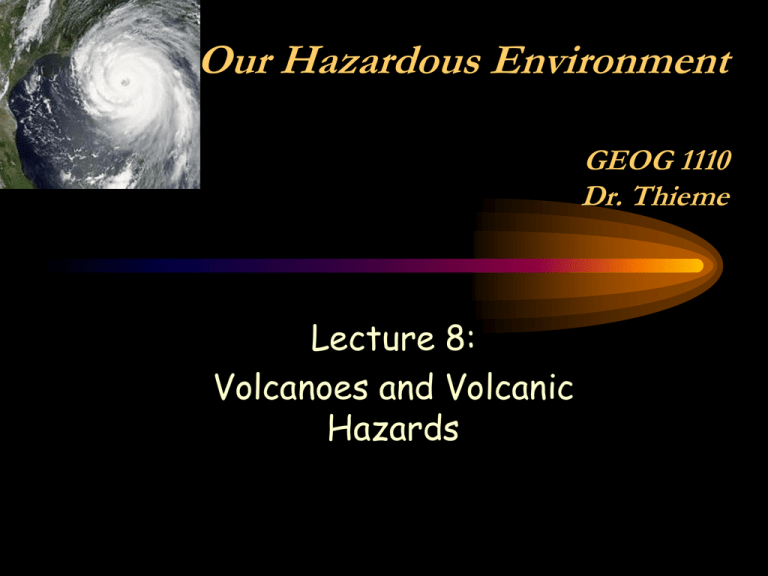
Our Hazardous Environment GEOG 1110 Dr. Thieme Lecture 8: Volcanoes and Volcanic Hazards Volcanoes • volcano - a conical or dome-shaped landform created when lava and/or tephra accumulates on the earth’s surface • lava - molten material on the surface • magma - molten material below the surface • tephra - igneous material, ranging in size from dust to boulders, that is explosively ejected from a volcano Distribution of Volcanoes 1. 2. 3. Most frequently associated with subduction zones Also common along mid-ocean ridges Some at hot spots, but much more rare • • • • • magma chamber - an accumulation of molten rock beneath the Earth’s surface vent - the opening magma uses to move from the magma chamber to the Earth’s surface crater - the opening through which lava and tephra issues caldera - a very large crater created by explosion or collapse cone - a build-up of lava and/or tephra around a vent, creating a hill or mountain Types of Volcanoes • There are 3 basic types of volcanoes 1) Shield volcanoes - largest 2) Stratovolcanoes (also called composite cones) 3) Cinder cones - smallest Shield Volcanoes • Created by mafic magma • Thin and flow easily in comparison to felsic magmas (less “viscous”) • Usually hold little gas in comparison to felsic magmas • Eruptions of volcanoes consisting of mafic magmas are relatively quiet because of the thin, fluid nature and the absence of gas under pressure • Mafic lava flows tend to travel long distances across the surface, and form broad-based volcanoes with gently sloping sides • Fissure eruptions on the sides of the volcanoes are common, called flank eruptions • Calderas often develop Shield Volcanoes • Composed of multiple stacked lava flows • Famous examples include Hawaii, Iceland, and the Azores. • Hawaii is formed over a hot spot, Iceland and the Azores over the Mid-Atlantic Ridge • hot spot - an area where a plume of magma is welling up from deep within the asthenosphere ’a ’a Pahoehoe Stratovolcanoes • Created by intermediate to felsic magmas – – – – – thick and gummy magma/lava magma/lava frequently high in gas content eruptions can be very explosive cones are composed of interlayered lava and tephra tall, steep-sided cones Stratovolcanoes • also called composite volcanoes or composite cones • stratovolcanoes are known for their scenic beauty • famous examples include: – Mount Rainier and Mount St. Helens in Washington – Mount Shasta in California – Mount Fujiyama in Japan • volcanoes that most concern scientists – explosive eruptions – glowing avalanches, scorching hot clouds of ash and debris – glowing avalanche from Mount Pelée on the Caribbean island of Martinique killed all but 2 of the 30,000 inhabitants of the city of St. Pierre in 1902 Composite Cone, Mount Shasta, northern California Mount Lassen • east of Redding, CA • erupted in June, 1914 Formation of Crater Lake Figure 4.13 Long Valley • caldera eruption • 700,000 years ago • tephra used to date other rocks and sediments ("tephrochronology") “Peléean” eruptions • • • • Silica-rich (“felsic”) magma form domes glowing avalanches ash flows Cinder Cones • made up entirely of tephra • form when frothy mafic magma is ejected from a vent under high pressure • rarely get more than a few hundred meters high, and they are the most easily eroded volcanic cone Volcanic Hazards • gases • CO2 • SO2 • H2S • F2 • lava flows • bombs, ash • pyroclastic flows • landslides • mudflows (“lahars”) Molten Sulfur and Sulfur Gases in an Indonesian volcano Lake Nyos, Cameroon, West Africa Carbon Monoxide (CO) is poisonous


